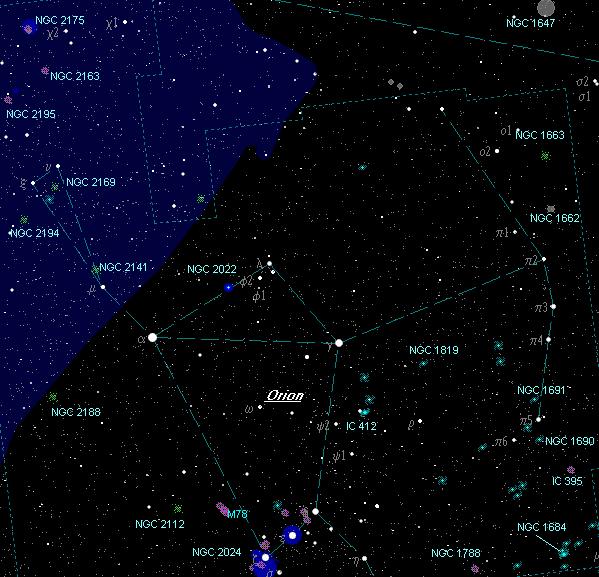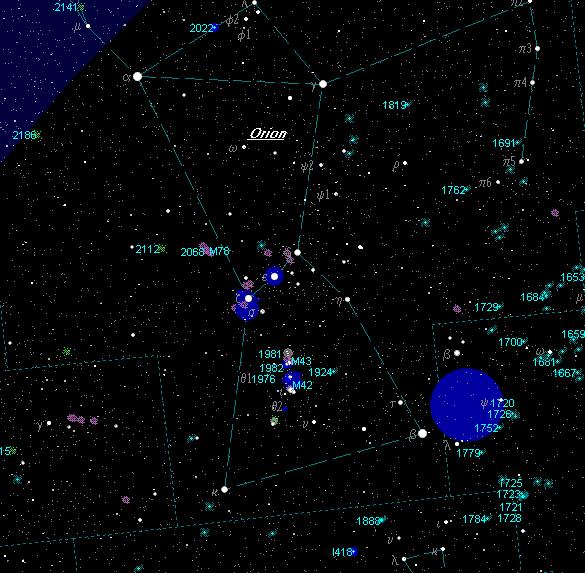Owning the Winter Sky
The constellation Orion is synonymous with frosty Canadian nights. With its majestic collection of bright suns and overall size, it truly owns the winter sky. Orion the Hunter lists as 26th in area as it holds the deed to 594 square degrees of celestial real estate. The three belt stars from (left to right) Alnitak, Alnilam and Mintaka string in a line within a degree below the celestial equator, so this is a good marker to help get your sky bearings. A bright asterism such as this helps identify neighbouring constellations such as Taurus the Bull to the North West, Auriga the Charioteer above, and Lepus the Hare under his feet. And like any great hunter, his two dogs named Canes Major and Minor are close by to his left.
There are quite a few celestial objects on the old observing list. Number one is the most viewed and photographed object – the Orion Nebula or M42. Hands down it is the brightest star-forming region ever observed and is large as well. This stellar nursery is estimated to be only 1500 light-years (ly) away and measures 85 X 60 arc minutes to its extreme edges. However, the inner brighter portion can easily be spotted with the naked eye. Also, catch Maia’s Nebula – M43.

But if you can drag yourself away from this gem, slide down a little more than a degree to a bluish reflection nebular catalogued as NGC 1999. Off to one side is a dark mass regarded as a Bok Globule. This is a large thick cloud of cold dust and gas that is obscuring starlight. NGC 1999 is also one of Hubble’s portraits. This unusual looking object is only a blip of a much larger region around this nebula. Located to the left of Alnitak in the belt is a semi faint emission nebula called the Flame Nebula. Also referred to as the Tank Track Nebula, NGC 2024 can be a little hard to spot. The trick is to place Alnitak out of the field of view. Deemed as an emission nebula, it is also being lit by Alnitak. The Flame Nebula is part of the Orion Molecular Cloud Complex, which is the star-forming region of M42 and also the famous Horsehead Nebula.
If you possess large optics and a blessed with a dark sky, the Horsehead Nebula (IC434) can be spotted. The linked image is rotated to the left. The Horsehead actually has a north-south orientation. Moving up from the Flame for about 2.3 degrees we come to M78 aka the Casper the Ghost. This reflection nebula glows at magnitude 8.0 and is pretty well the same distance as the Orion Nebula at 1500 light-years (ly). M78 is also estimated to be 5 ly in width.

Still moving higher in declination, locate NGC 2169. Once you have centred on it, you will see how it got its name. The “37” or “LE” cluster is quite evident. It lies some 3,600 ly away and is just under naked eye limits at magnitude 5.9. At the northern extreme of the constellation is the emission nebula IC 2159 which is part of NGC 2175. Although observable, it appears to be a photographic target. Close to three degrees south of NGC 2175 is a nice little star line up. However, NGC 2195 is devoted to the double star in the chair. I am not sure if there are others but this is the first time I have seen an NGC designation given to a double star.
Sliding over to the right side of the Hunter, we start from the bottom foot and the Star Rigel. Rigel is Orion’s second brightest star and is ranked seventh in the entire sky. A blue supergiant star that shines as bright as 40,000 of our Suns, Rigel’s surface temperature is twice that of Sol or 11,000 degrees Kelvin. This celestial beacon helps light the close by Witch Head Nebula – IC 2118 in Eridanus. The Witch Head resides only 40 ly from Rigel but is 775 ly from us.
The borders of Orion contain a handful of galaxies down to fourteenth magnitude. One remote galaxy if NGC 1819. This 13th magnitude elongated galaxy is located 3.3 degrees west of one of the hottest naked eye stars - Bellatrix (right shoulder of the Hunter). NGC 1819 measures 1.3 x 1.0 arc minutes. Supernova SN 2005el was discovered in the galaxy in September 2005. If you have a chance, locate NGC 1788. This is a combination of an emission and reflection nebula. The brightest portion of nebulosity runs from northwest to southeast. NGC 1788 is estimated to be 2,500 ly away. A strange-looking object is IC 2162. Here we have two glowing clouds of star formation which are also referred to as Newton’s Nebula.
Toward the right corner is the constellation’s boundary is a group of three round galaxies within an area of ten arc minutes. Here we have NGC 1685, NGC 1684 and NGC 1682. The light levels register at magnitudes 14th, 13th, and 14th respectively.
| Object | Type | Magnitude | R.A. | Dec. |
|---|---|---|---|---|
| IC 2162 | Emission nebula | 8.9 | 06h 12m 54.0s | +17° 59' 00" |
| IC 413 | Spiral galaxy | 13.8 | 05h 22m 0.0s | +03° 29' 00" |
| NGC 1662 | Scattered open cluster |
6.4 | 04h 48m 30.0s | +10° 56' 00" |
| NGC 1663 | Open cluster | 11.1 | 04h 48m 36.0s | +13° 10' 00" |
| NGC 1670 | Round galaxy | 14.0 | 04h 49m 54.0s | -02° 44' 00" |
| NGC 1689 | Round galaxy | 12.9 | 04h 52m 30.0s | -03° 06' 00" |
| NGC 1690 | Round galaxy | 14.0 | 04h 54m 18.0s | +01° 38' 00" |
| NGC 1691 | Round galaxy | 13.0 | 04h 54m 36.0s | +03° 15' 00" |
| NGC 1713 | Round galaxy | 13.9 | 04h 58m 54.0s | -00° 30' 00" |
| NGC 1719 | Elongated galaxy | 14.0 | 04h 59m 35.9s | -00° 16' 00" |
| NGC 1729 | Elongated galaxy | 13.1 | 05h 00m 6.0s | -03° 21' 00" |
| NGC 1762 | Elongated galaxy | 13.1 | 05h 03m 35.9s | +01° 34' 00" |
| NGC 1788 | Bright reflection nebula |
9.0 | 05h 06m 54.0s | -03° 21' 00" |
| NGC 1819 | Elongated galaxy | 13.0 | 05h 11m 42.0s | +05° 12' 00" |
| NGC 1976 | Bright emission nebula – M42 |
4.0 | 05h 35m 24.0s | -05° 27' 00" |
| NGC 1981 | Scattered open cluster |
4.6 | 05h 35m 12.0s | -04° 26' 00" |
| NGC 1982 | Bright nebula with dust |
9.0 | 05h 35m 36.0s | -05° 16' 00" |
| NGC 2022 | Planetary nebula ring |
12.0 | 05h 42m 5.9s | +09° 05' 00" |
| NGC 2068 | Reflection nebula | 8.0 | 05h 46m 42.0s | +00° 03' 00" |
| NGC 2112 | Rich open cluster |
9.0 | 05h 53m 54.0s | +00° 24' 00" |
| NGC 2141 | Rich open cluster |
9.4 | 06h 03m 6.0s | +10° 26' 00" |
| NGC 2169 | Scattered open cluster |
5.9 | 06h 08m 24.0s | +13° 57' 00" |
| NGC 2175 | Open cluster | 2.8 | 06h 59m 42.0s | +35° 17' 00" |
| NGC 2188 | Edge-on galaxy | 11.8 | 06h 10m 5.9s | -34° 06' 00" |
| NGC 2194 | Dense open cluster |
8.5 | 06h 13m 48.0s | +12° 48' 00" |
| NGC 2195 | Emission nebula | 10.2 | 06h 14m 24.0s | +17° 38' 59" |
| NGC 2207 | Galaxy merging with IC 2163 |
10.7 | 06h 16m 24.0s | -21° 22' 00" |
The red planet Mars is still putting on a good show. Since it was closest to us on December 24th at 88 million kilometres, our separation is ever increasing as the days march on. Throughout January Mars slowly treks westward against the star and this is due to retrograde motion. Simply the Earth is overtaking Mars since we are closer to the Sun than Mars. It will become stationary in the sky on January 30th and then move eastward from then on. And speaking of the 30th, astronomers believe that Mars hit by asteroid 2007 WD5 on that date.
For now, there is a 1 to 75 chance that the 50-meter rock will impact the red planet but if it does, it will do so around the equator and close to the Opportunity spacecraft. The energy release will equal that of a 15 mega-tonnes of TNT and comparable to the Tunguska event of 1908 and dig out a crater about 1.5 km in width.
If the event is on schedule, it will occur a few minutes before 6 a.m. est. Unfortunately, Mars will have set in the west by then for the eastern population. Observers in central and western areas of the country will have a better chance to witness the event – if it occurs. However, such a small impact will most likely be picked up by the Hubble Space Telescope. But we do live in the electronic age with CCD cameras and webcams. Who knows what will be picked up in the backyard observatory. As we draw closer to Jan 30th, estimates will be revised. Follow the developments with the spaceweather.com as well as the RASC eNews.
The planet Saturn is marching up the sky and can be seen by midnight in the east and by 10 p.m. by month’s end. Caused by its 29-year orbital movement around the Sun, the planet’s rings appear to be tilting to the closed position. We will indeed see the rings edge-on in March of 2009. Following the angle tilt over the next fifteen months as the gap gets smaller. We see one hemisphere for about 16 years than the other hemisphere for the remaining 13 years.
As we close our 2007 log books and reflect on our sessions with the revisit of favourite celestial objects and the hunting down of new ones, we should also ponder many of the great discoveries the last twelve months had to offer. We have had a few surprises such as the October 25th outburst of Comet Holmes. Holmes is now a few times the size of the Sun and is growing fainter by the night.
With the release of new material, the comet brightened a millionfold overnight. With the list of scheduled events in the sky such as eclipses and close conjunctions of the Moon with planets, Mars might be lined up for a hit from an asteroid, half a football field in length. Have a happy, healthy and safe 2008 and may your skies stay clear. But most of all, take the time to introduce the night sky to others as it truly is Mother Nature’s greatest show.
Until next month – clear skies everyone.
Gary Boyle
